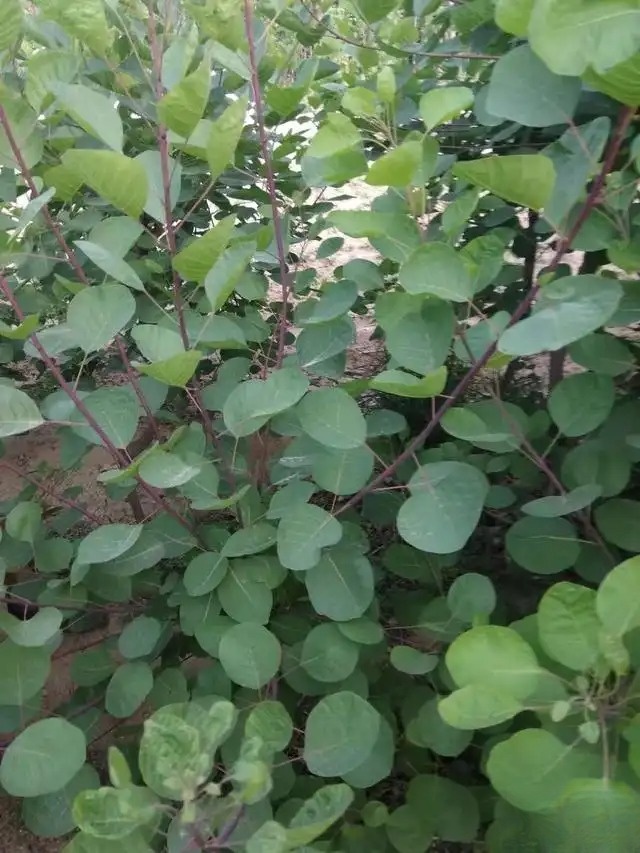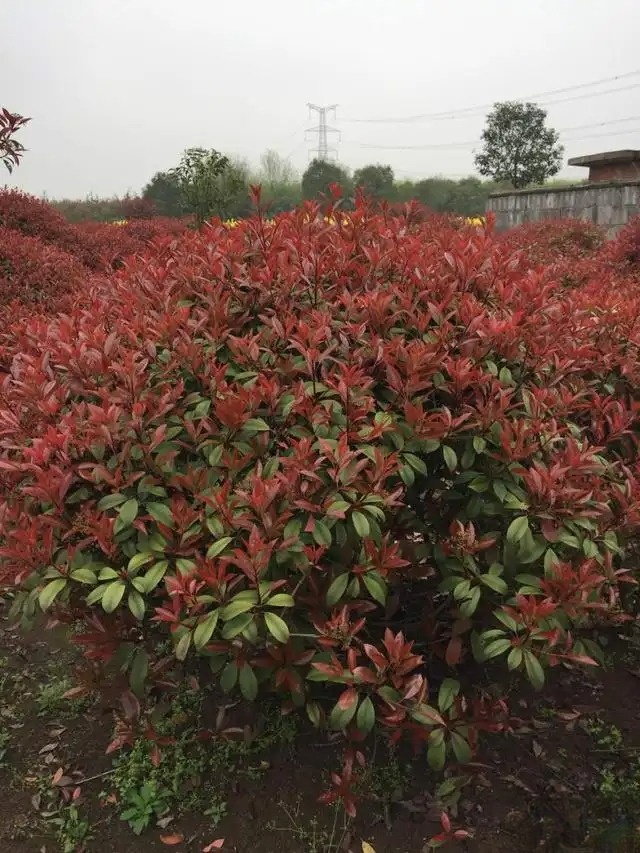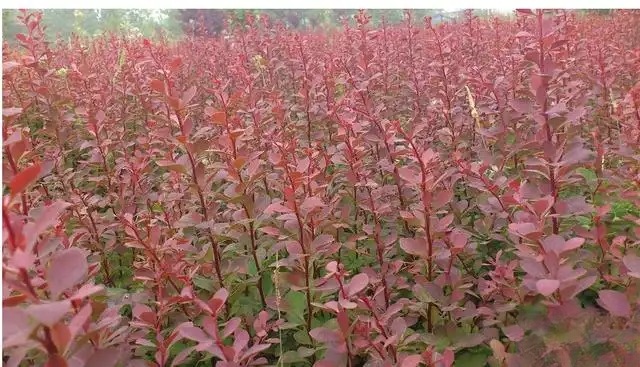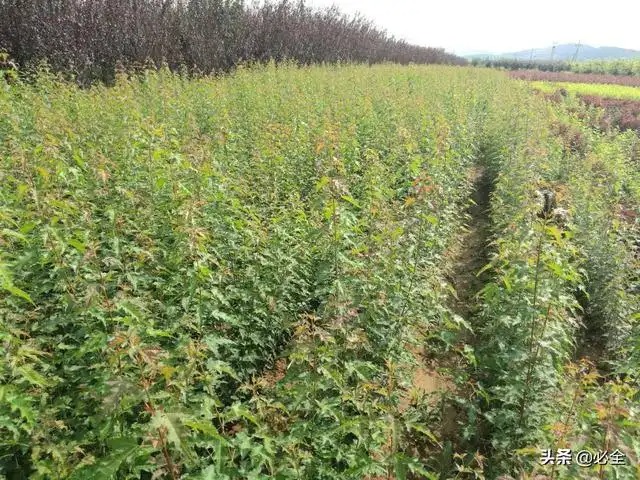These 20 colorful tree species are the first choice for landscaping
As people's appreciation of gardens and gardening works continues to improve, they are more picky about the selection and use of seedlings. From simple greening to fine greening, and then to coloring, the requirements for the variety, quality and comprehensive form of seedlings are getting higher and higher. Colorful leaf trees are a popular tree species in recent years. It can become a landscape in a garden tourist park, and it can also add color to urban greening. These 20 kinds of colorful leaf tree species are the first choice for garden greening:
1. Cotinus coggygria
Cotinus coggygria is an important ornamental red-leaf tree species. Its leaves turn red in autumn, which is bright and eye-catching. It is suitable for planting in lawns, mounds or hillsides in gardens. It can also be mixed with other trees, especially evergreen trees. The famous red leaves of Beijing Xiangshan are this tree species. The pedicels of the sterile flowers of Cotinus coggygria that stay for a long time after flowering are pink and feathery, forming a cloud-like and fog-like landscape on the branches.

2. Red Leaf Plum
Red-leaf plum, with purple-red leaves all year round, is a famous foliage tree species. It is suitable for single or group planting and can set off the background. Especially the purple shiny leaves, among the green leaves, are like everlasting flowers, forming a beautiful landscape among the green mountains and green waters. Red-leaf plum has a wide range of uses in garden greening. It can be planted in streets, flower beds, around buildings, on both sides of roads, etc. It can be planted alone around the square and on the central lawn. Red-leaf plum is also a commonly used garden ornamental tree species.
3. Red Flower
According to the leaf color, the red loblolly can be divided into three types of cultivated species: tender red, bone-penetrating red, and double-sided red. The red loblolly can be planted alone, in clusters, or in groups. It can also be pruned into a spherical shape and used in villas or courtyards, or as a color fence or a modeling tree. It can also be used to cultivate the double-sided red loblolly for directional pile landscape shaping. It is more commonly used in high-end gardens and cultivated into small trees as street trees.
4. Euonymus davidianus
Euonymus davidianus is a new and excellent colorful leaf plant introduced from abroad. Its leaves are bright purple-red, bright and beautiful, and more ornamental than other purple-leaved plants. The leaves turn red in autumn and the color is bright. It grows slowly and has a neat plant shape. It has strong resistance and is suitable for color hedges.
5. Photinia fraseri
The new leaves of Photinia fraseri are bright red in spring, turn green in summer, and turn red in autumn, winter, and spring. The color becomes darker when the frost is heavy, and the color is better at low temperatures. When used as a street tree, its stem stands like a torch; when used as a hedge, it looks like a dragon; when pruned for landscaping, it can be shaped in various ways, with beautiful landscape effects. Photinia fraseri is named for its bright red new shoots and young leaves. In spring and autumn, the new shoots and young leaves of Photinia fraseri are bright red, with bright and long-lasting colors and full of vitality. In the hot summer season, the leaves turn bright green, giving people a refreshing and cool feeling.

6. Blue Honeysuckle
The new leaves of blue honeysuckle are tender green, and the old leaves are dark green with a hint of blue. The flowers are red, and the flowering period is from April to June. The berries are bright red. Blue honeysuckle has a large number of flowers, delicate leaves, and a very fashionable blue-green leaf color. It is a low-maintenance variety with good resistance. It is often planted in courtyards and communities for viewing. Its leaves, flowers, and fruits are all ornamental, and it is often planted in gardens, parks, etc., and can also be planted as a hedge.
7. Golden Leaf Physalis
Golden leafed physalis is a natural variant of glabrous physalis, an excellent colorful shrub. It is an ornamental shrub of the Rosaceae family introduced to enrich the greening level and color. Its leaves, flowers and fruits are all ornamental. The golden yellow and bright green form a sharp contrast, which greatly increases the level of the shape and the brightness of the green plants. In urban greening, it can be planted alone, in clusters or in strips. It is suitable for courtyard viewing, and can also be used as road hedges, inlay materials, strip flower bed backing, or flower paths or edging.
8. Purple-Leafed Canadian Redbud
The purple-leafed Canadian redbud has bright purple-red leaves and purple-red flowers in summer. The flowers are shaped like butterflies, and the whole tree is purple-red, gorgeous and lovely. The purple-leafed Canadian redbud is a new variety of garden ornamental with excellent leaves, flowers and fruits. It is suitable for planting in courtyards, offices, parks, roadsides and scenic spots.
9. Acer truncatum
The fruit of the Acer truncatum is ornamental, and the leaf shape is beautiful. The leaves are bright red in autumn, which is particularly eye-catching; the double-winged fruits just formed in summer are pink, very delicate and unique. It is an excellent ornamental greening tree species in the north, suitable for solitary planting, row planting, group planting, or trimming into hedges and plastic trees.
10. Red Leaf Peach
Red Leaf Peach is a variant of Peach. It likes warm and sunny environment and fertile and well-drained soil. Red Leaf Peach not only has beautiful flowers but also red leaves. It can be planted with Malus chinensis, Syringa japonica and Prunus mume. It is widely used in lakeside, stream, roadside and park in landscaping. It is also used for potted ornamental in small greening projects such as courtyard greening and private gardens. It is also often used for cut flowers and bonsai.
11. Berberis chinensis
The leaves of Berberis vulgaris are golden yellow all year round, the flowers are yellow and drooping, and the red berries are oblong. The leaves are brighter in color at the turn of spring and summer, and the viewing period is long. It has a very broad prospect for promotion and application in garden greening construction. It is a rare and important yellow element variety in urban garden greening construction. It can not only be used as a pattern and color matching for green landscaping, but also can be used to make hedges or potted plants.
12. Berberis rubrum
Berberis rubra is purple-red in color, blooms in spring and bears fruit in autumn. It is often used in landscaping, is cheap and has good quality. It can be widely used in streets, courtyards, parks, etc., and is an important color material for landscaping. It can be used as an independent landscape, and pay attention to the strong contrast with the surrounding landscape to achieve the effect of "a little red in the green".

13. Golden Branch Sophora japonica
The golden-branched Sophora japonica sprouts early, and the young buds and tender leaves are light yellow. They turn green and yellow in early May, and turn yellow again after September in autumn. From November to May of the following year, its branches are golden yellow, hence the name. It is an excellent tree species for greening and beautification.
Golden Sophora japonica is widely used in gardening and is one of the colorful tree species for roads, scenic spots and other gardening. Golden Sophora japonica not only has ornamental value in all seasons, but also improves the stability of the group and has a good landscape effect when mixed with other tree species due to its ecological characteristics. In landscape configuration, it can be used as both the main tree species and the mixed tree species, and is suitable for landscape configuration with various planting effects such as solitary planting, clump planting and group planting.
14. Acer truncatum
Acer truncatum is a common greening plant in northern gardens. Its leaves are often 5-lobed, and the bases of the two lowest lobes are almost in a straight line, so it is also called flat-base maple . In autumn, when its fruits mature, the two seeds on the left and right are each attached with an extended wing, which spread out side by side. The overall outline is like an ancient gold ingot, so it is called Acer truncatum.
The maple has a large crown and dense shade, and the tree has an elegant posture and beautiful leaves. Its young leaves are red, and in autumn the leaves turn orange or red. It is an important autumn-colored leaf tree in the north. It is planted as a garden shade tree and street tree in various provinces in North China. It is elegant when planted on embankments, lakeside, grasslands, and near buildings.
15. Japanese Acer palmatum
Acer palmatum can be planted as a roadside or ornamental tree, and is a good "four-season" greening tree species. In gardening, different varieties are often arranged together to form a colorful maple garden; maple varieties can also be mixed in evergreen trees to create a "red dot in the green" landscape; planted at the foot of the mountain or by the pool to show its chic and graceful grace; paired with rocks, it is more quaint. In addition, it can also be planted in flower beds as the main landscape tree, planted on both sides of the garden gate, and in the corners of buildings to decorate the scenery; potted for indoor beautification, it is also very elegant.
16. Acer truncatum
The triangular maple has an elegant posture and beautiful bark. Its flowers are yellow-green in spring and its leaves turn red in autumn. It is a good gardening and foliage-viewing tree. It is suitable for use as a roadside or garden shade tree or as an embellishment on the lawn. It is resistant to pruning and can be shaped into a coil and used as a stump bonsai. The wood of the tree is excellent and can be used to make farm tools; it is cultivated as a hedge in Nanjing.

17. Maple
Generally refers to the ash-leaved maple, which was originally distributed in North America. It has been introduced to Liaoning, Inner Mongolia, Hebei, Shandong, Henan, Shaanxi, Gansu, Xinjiang, Jiangsu, Zhejiang, Jiangxi, Hubei and other provinces and regions and is cultivated in major cities. It grows well in the provinces and cities of Northeast China and North China. It is a light-loving and positive tree species with strong adaptability, cold resistance and drought resistance. It likes to grow in moist and fertile soil, is slightly tolerant of water and humidity, but can also grow on drier soil. This species blooms in early spring and has rich nectar, making it a good nectar source plant. It grows rapidly, has a broad crown, and has good shade conditions in summer. It can be used as a street tree or garden tree to green cities or factories and mines.
18. Red Leaf Poplar
Red-leaf poplar is a new variety of poplar cultivated in 2000. It is a new variety of colorful leaves, also known as color-changing poplar. Red-leaf poplar is not only a tall tree, but also has large and thick leaves. The color of the leaves changes in three seasons. In normal years, the leaves unfold around March 20. The leaves are rose red and can last until late June. From July to September, they turn purple-green, dark green in October, and apricot or golden yellow in November. The trunk is purple-red before the end of July. The petiole, veins and new shoots are always red, with bright and attractive colors. It is rare in the world and has high ornamental value. It is a treasure among the red-leaf species of colorful leaf trees and can be widely planted in urban greening.
19. Chinese tallow tree
The leaves of the Chinese tallow tree are regular rhombus-shaped, which is quite unique among plant leaf shapes, so it is also a very easy-to-recognize tree species. In autumn, Chinese tallow trees often turn bright orange-red. When planted in groups by the lake or on the grass, they often create an ornamental effect similar to red maple trees. Because they are often planted by the water in the south, some people speculate that the "river maple" in the poem "The moon sets, the crows cry, and the sky is full of frost. The river maple trees and the fishing fires face the sad sleep" are most likely Chinese tallow trees.
20. Torchwood
Torchwood is a small deciduous tree of the genus Rhus genus in the Anacardiaceae family. It has alternate odd-pinnate compound leaves that are oblong to lanceolate. It has an upright panicle at the end of the inflorescence and a bright red fruit spike. The fruit is oblate and has red prickles that are tightly clustered into a torch shape. The fruit matures in September and does not fall off for a long time. In autumn, the leaves turn red, which is very spectacular.
Follow the "Biquan" headline account to learn more about the garden industry.